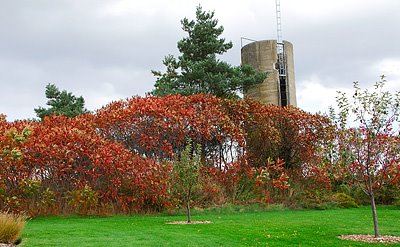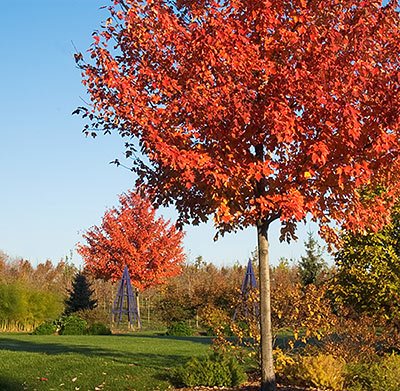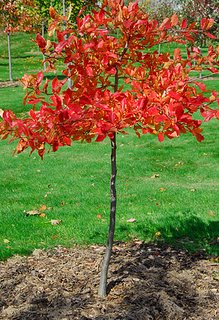
We have plain old staghorn sumac growing around our old silo – all that's left of the old barn site – and it's the perfect landscaping for that spot, courtesy of Mother Nature. Before we came, a previous owner had also planted a few Scotch pines around the silo, and the pine/sumac combination looks wonderful. We keep the sumac in bounds by mowing around the silo.
Staghorn sumac (
Rhus typhina) isn't often planted as a garden shrub because it is one of those great spreading shrubs, suckering from the roots to form a large colony. Maybe the other reason sumac is not much appreciated is that it grows wild all around us.
Woody plant expert Michael Dirr warns that it has to be sited carefully, and that it needs maintenance to keep it in bounds, but he adds: "Europeans have long appreciated
R. glabra [smooth sumac] and
R. typhina. Perhaps some day Americans will become more introspective and appreciative of our rich woody plant heritage."
That aside, staghorn sumac is a great plant for acreages, where its wandering ways can be appreciated. The cutleaf cultivars are very graceful and have the best orange-red fall color.

Perhaps foolishly*, I've planted the cutleaf sumac 'Laciniata' in a small bed at the corner of the house (shown here). The area is surrounded by an upper and lower patio, which theoretically should keep the plant contained. I just hope it won't damage the house foundation. (Dirr says not to use it as a foundation plant!)
I guess we can always tear it out if it gets to be a problem. For now, I just enjoy the great fall color, and I take heart from the advice about using this plant from the Brooklyn Botanic Garden:
Cutleaf staghorn sumac has ornamental possibilities that go beyond heavy-duty applications like highway landscaping. For large suburban properties it makes a good buffer plant for peripheral areas, where it provides not only summer privacy but food and habitat for animals as well; it makes an excellent "transitional plant" between tamed and wild areas.
With its size controlled by pruning and/or root confinement, cutleaf staghorn sumac can be used in manicured gardens. It can serve as a bolder, textured alternative to the ubiquitous dogwood and Japanese maple when planted off the corner of a structure to anchor a foundation planting. For hot outdoor plazas, it is a rugged survivor and makes a strong "statement."
For a mixed perennial border with a bold texture, try it as a specimen shrub to be cut back to the ground annually. Its wild appearance mixes especially well with grasses, and its spectacular fall color adds beautifully to any display of asters, chrysanthemums or goldenrod.
You can read the full article
here.
(By the way, if you're wondering about the metal tower on the silo in the picture at the top, it's for our high-speed internet receiver. High-speed internet, can't live without it, right?)
*Three years on, spring 2009: We pulled that cutleaf sumac by the house out because it was taking over. The main plant was reaching everywhere and going under the patio with its amazing spreading root system. We've had to be vigilant to dig out all the bits all season long to keep at the ones we missed the first time. Lesson learned: this is a plant for the back 40!













